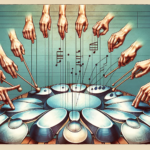The world of music has always been diverse and rich with cultural influences, and this vibrancy extends to instruments that are both traditional and contemporary. Amongst these, the handpan is an intriguing addition. Originating relatively recently, the handpan has quickly found a niche in the global music scene. Characterized by its unique sound and captivating aesthetics, this steel pan-inspired instrument is making waves in different musical cultures around the world.
History and Origin of the Handpan
The handpan, also known as a hang drum, was first manufactured in the early 2000s by Swiss inventors Felix Rohner and Sabina Schärer of PANArt. Inspired by the Trinidadian steelpan, Indonesian gamelan, and Indian ghatam, the creators sought to produce an entirely new percussion instrument. PANArt’s first instrument, the Hang, had a resonant, ethereal quality that captivated musicians and listeners alike. The instrument was designed to be played with the hands, which distinguished it from the traditional steelpan played with mallets.
Design and Construction
The handpan’s construction contributes significantly to its appeal. Typically, it consists of two metal hemispheres glued together with a hollow interior, creating resonant chambers that amplify sound. The top hemisphere, known as the “ding” side, features a central dome surrounded by several tone fields or notes. The bottom side, or “gu” side, often has a central hole that further enhances the instrument’s tonality and resonance.
Different makers and brands produce handpans with varying sizes, scales, and tunings, resulting in diverse sound characteristics. This variety allows for a wide range of musical expressions and styles, making the handpan versatile across global music genres.
Global Appeal and Integration in World Music
The handpan has gained popularity worldwide, transcending its European origins to be embraced by musicians from different cultures. Its melodious, meditative sounds have found a place in various musical traditions, from traditional and folk music to contemporary and experimental genres.
Traditional Music
In traditional settings, the handpan complements instruments like the sitar in Indian classical music or the duduk in Armenian folk music. Its harmonious tones blend well with these instruments, creating a seamless fusion of old and new sounds.
Modern and Experimental Music
In the contemporary music scene, artists are incorporating the handpan in genres like jazz, electronic, and ambient music. The distinctiveness of its sound provides a unique texture that enhances the musical landscape. For example, it is used to create intricate rhythmic patterns in electronic music or to add a layer of organic sound in ambient compositions.
Musicians such as Manu Delago have brought the handpan to wider audiences through collaborations with well-known artists like Björk and Anoushka Shankar. These collaborations have showcased the handpan’s versatility and emphasized its potential for broad musical applications.
Handpan’s Role in Therapeutic and Meditative Practices
Beyond its musical contributions, the handpan also plays a significant role in wellness practices. The serene, calming tones of the instrument are ideal for meditation, yoga, and therapeutic settings. Practitioners of sound therapy often use the handpan to facilitate relaxation, stress relief, and mental clarity.
Its timbre, often described as soothing and otherworldly, can induce a state of tranquility, making it an excellent tool for creating meditative soundscapes. Sound baths, which employ various instruments to create immersive auditory experiences, frequently feature the handpan due to its ability to produce sustained, harmonious sounds.
The Community and Craftsmanship
The handpan community is a testament to the instrument’s growing global significance. Enthusiasts and craftsmen from different parts of the world converge to celebrate and share their passion for the handpan. Festivals, workshops, and online forums create platforms for musicians and makers to connect, collaborate, and innovate.
Craftsmanship plays a pivotal role in the handpan’s evolution. Each instrument is meticulously handcrafted, and this artisanal approach ensures a unique musical personality for every handpan. Builders experiment with different materials, shapes, and tuning techniques to produce distinct sounds, further enriching the handpan’s diversity.
Conclusion
The handpan, with its relatively short history, has managed to carve a niche in the world of music. Its unique sound, versatility, and therapeutic qualities have made it a beloved instrument across various cultures and musical genres. From traditional to contemporary music, and from casual playing to professional therapeutic practices, the handpan continues to enchant and inspire people worldwide. As musicians and craftsmen explore its potential further, the handpan is likely to remain a significant influence in global musical dynamics.
FAQs
1. What is the difference between a handpan and a hang drum?
The handpan and the hang drum are often used interchangeably, but there is a difference. The hang drum was the original instrument created by PANArt and is technically a type of handpan. Handpan has become a generic term referring to similar steel percussion instruments inspired by the hang drum.
2. How do you play a handpan?
The handpan is played with the hands and fingers by striking different tone fields to produce various notes. Techniques include tapping, slapping, and gliding to create rhythmic and melodic patterns. It can be played solo or with other instruments.
3. What types of music can you play with a handpan?
The handpan is versatile and can be integrated into multiple music genres, including traditional/folk music, classical, jazz, ambient, electronic, and experimental compositions. Its unique sound adds a distinctive texture to any musical arrangement.
4. Are handpans expensive?
Handpans can be quite expensive due to their handcrafted nature and the intricate process involved in their making. Prices vary depending on the maker, materials, and craftsmanship, often ranging from a few hundred to several thousand dollars.
5. How can I learn to play the handpan?
There are several ways to learn the handpan, including online tutorials, instructional videos, workshops, and private lessons. Joining handpan communities or attending festivals can also provide valuable insights and hands-on learning experiences.





